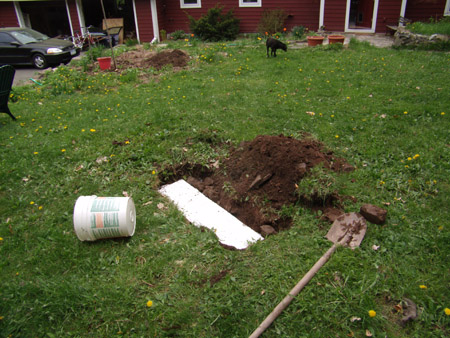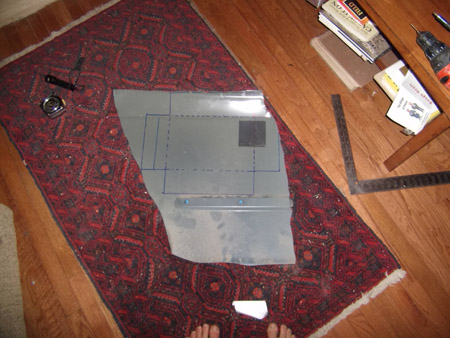|
|
|
personal archæological site
Thursday, May 8 2008
Watching the episode about the manufacture of caskets on the Discovery Channel's Some Assembly Required had been a groan-inducing experience. Why would anyone want his corpse shot full of chemicals and placed in a sealed steel container? What possible good could be gained by having one's earthly remains remain in a recognizable, biologically-unhelpful form well past one's expiration date? And why go through the trouble of containing it all in a steel casket with a sacrificial zinc anode? What difference does it make if a coffin lasts a month or a thousand years? Nobody is going to know once it's buried! What justifies such useless expenditure? The same feelings that makes us recoil at our other connections with nature? (These would include widespread denial of Darwinian evolution, sexual guilt, and discomfort with feces.)
Still, it's difficult not to think about the material legacy once leaves when one dies. The body seems the most perishable, so I don't have any plans for mine once I'm dead. I'd prefer it to be quickly devoured by vultures and coyotes, though my feelings about it aren't strong. I tend to think more about the durable artifacts of my life and how they might look were they to turn up in an archæological site of the distant future. For this reason, I actually find satisfaction in building time capsules and in burying non-toxic building materials in the yard (as opposed to consigning them to anonymity in a landfill). Normally I bury things like nails, chunks of asphalt paving, or drywall, but today I buried something more durable: the thickly-glazed white bathroom tile that had once covered the woodstove's pedestal. I'd removed it in sheets, with the Portland-cement-based Wonderboard still attached, and I hoped that the gradual decomposition of the cement would improve the overlying soil, much the way limestone does. (The rock in this area contains little calcium carbonate, leaving the soil acidic, relatively unproductive and snail-free.)
Whenever I bury artifacts in the yard, I choose a site whose topographic profile might be helpfully raised, either because it is too low or because it is adjacent to a high spot whose surrounding slopes are too steep. All of this is with a view to making the lawn an easier thing to mow. I buried the tile adjacent to the lawn's most unexpected high spot, a place Gretchen and I refer to as "the grassy knoll." When we'd first moved to Hurley, this spot had been occupied by a large tree stump that proved impossible to remove. So I'd buried it instead, creating a hill whose steep sides had proved difficult to mow. Over the years I'd gentled its slope with occasional additions of soil, but they could always stand more gentling still.
As I excavated a large hole, I found remnants of the stump's old roots. Though they had barely rotted at all, they had somehow divided into small pieces which I could easily lift out of the ground. The soil here was extremely rocky, though the rocks (like the roots) were broken into easily-removed pieces. I sorted out nearly all the rock from the earth, returning only the soil, small pebbles, and clods of turf when I filled in the hole over my archæological legacy. I piled the larger, flatter rocks I'd removed into two pyramidal cairns atop the large bluestone barbecue grill, which is covered with weeds and blackberry vines (among other symptoms of having fallen into ruin, a predictable consequence of vegans displacing the children of a butcher).
Once the tile was out of the way, it opened up a place behind the woodshed for the gutted hatchback's doors and hatch. I also discovered that the hatchback's roof fit nicely over the truck bed shell that serves as a redneck annex protruding out of the back of the woodshed. Putting it there meant that it would occupy essentially no space at all.
With the doors no longer blocking my access to the large pile of wood in the garage, I could use my firewood cart to begin moving it up to its proper home in the woodshed. This whole elaborate choreography of stuff was exercising my many right-brain spacial-processing neurons, some of which haven't had such a workout since I last played a rousing game of Tetris.
This evening, I attempted to make a shallow metal box out of a piece of sheet metal from the hatchback. Everything was going well until I attempted to weld it seams together. At that point I discovered that it was nearly impossible to weld through the panel's thick layer of paint. The paint caught on fire, releasing noxious chemicals into the air. Or else it prevented me from starting an electrical arc. It turned out that the sheet metal wasn't just painted on the outside; its grey underbelly, which looked for all the world to be bare metal, was actually covered with a layer of paint as well.

Digging a hole in the yard just this side of the grassy knoll.
That's the replacement hatchback in the background.

A sheet of abandoned bathroom tile, just before filling in the hole.
The bucket had contained tiny shards of broken tile.
In the background you can see Sally.

A piece of car sheet metal, marked up for cutting and bending to make that box I mentioned.
Yes, those are my toes.
For linking purposes this article's URL is:
http://asecular.com/blog.php?080508 feedback
previous | next |


